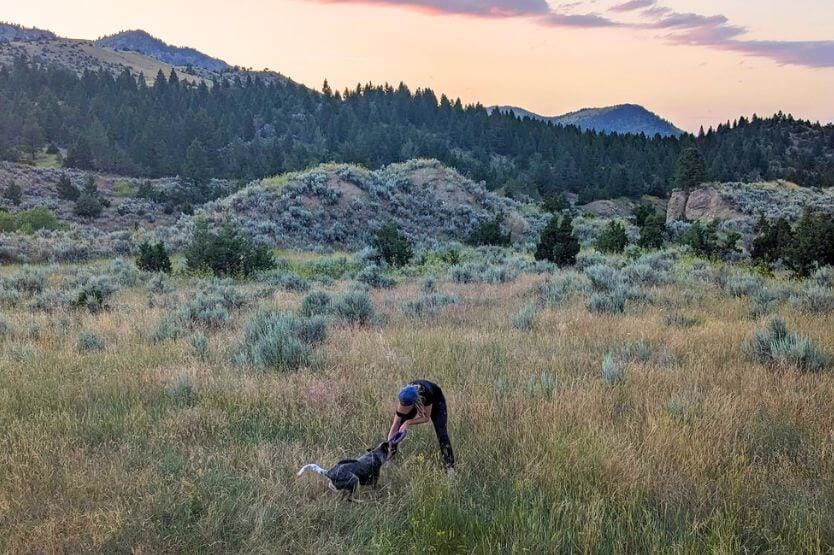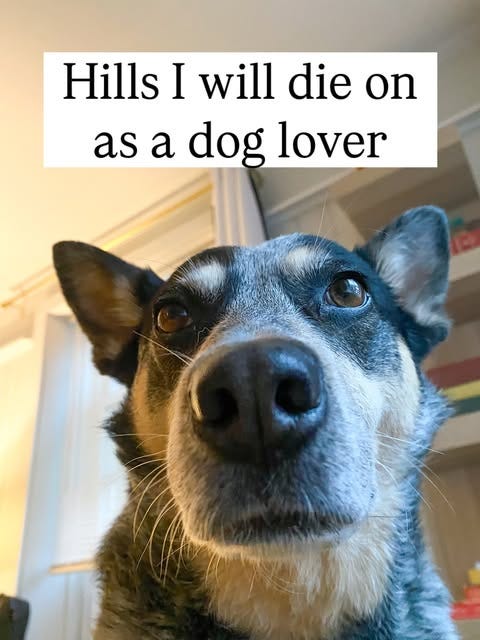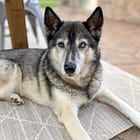Hills I will die on as a dog lover
The more specific a guideline, the more likely I am to take issue with it. But I stand behind some overarching beliefs.
You could say my “whole thing” is nuance.
I’m a big believer in adjusting to individual lifestyles, basing goals on personal values, and freely changing our minds. My go-to answer on any dog topic is “it depends”—not as a cop out (I promise) but because our decisions are affected by so many variables.
This means I subscribe to almost no hard-and-fast rules. The more specific a guideline? The more likely I am to take issue with it. But I do stand behind some overarching beliefs. Here are hills I will die on as a dog lover.
(Above: The condensed Instagram version of this post.)
1) Domestic dogs and humans are social creatures!
Our ancestors coevolved with each other through generations and generations, making our cross-species bond arguably the strongest in the animal kingdom. Many dogs seek human contact over that of other canines.
Dog is Love by Clive Wynne and The Genius of Dogs by Brian Hare are some of my favorite reads about dog-human relationships. Canine emotions and intuition aren’t perfect in our anthropocentric world… but they do go a long way. I’m increasingly uncomfortable with advice to restrict affection, make our dogs “work” for every interaction they have with us, or rely on transactional food exchanges.
More social bond thoughts:
2) Love is necessary, but not sufficient
This depends on how, exactly, we define love. (Once again: Nuance, my friends!)
I’ll be the first to talk about how much I adore my cattle dog and the importance I place on our mutual connection. But simply feeling a sensation of love isn’t enough to create a sustainable life.
Every relationship must balance give and take. We need enough baseline compatibility to enable us to cooperate through inevitable bumps in the road—and then we need to prioritize where we put our limited resources.
Related posts:
3) Our dogs deserve to be physically, mentally, and socially fulfilled
Scout fits into my daily routines as best she can amidst the chaos of our human world. It’s only fair that I try to do right by her in return.
I particularly like how dog trainer Jay Jack understands biological fulfillment. His podcast episode on leash reactivity is one of my favorites, explaining how many things we ask modern dogs to do are deeply unnatural—and therefore inherently stressful—for them. (I recommend listening even if your dog has no behavioral problems.)
I also enjoy this Denise Fenzi quote: “The way to get the dog on your side is not through deprivation of alternatives.” It helped me understand that the more I fulfill Scout’s natural instincts, the better our relationship will be.
I’ve talked about fulfillment a lot before:
4) Humans and dogs need to play
My favorite way to fulfill Scout physically, mentally, and socially all in one? Play!
Games like tug and fetch can satisfy my cattle dog’s natural instincts in a safe way. Play releases dopamine, serotonin, and oxytocin—which not only make us feel great but also encourage a deeper bond. And through play, we can teach our dogs valuable skills like impulse control and emotional regulation.
Play is one of my favorite topics. (Read: I can’t shut up about it!)
5) Where you live with your dog is much less important than what you’re willing to do with your dog
If we care enough about living a good life with our dogs, we can make it work just about anywhere.
That’s not to say it will be easy or ideal. We might need to make adjustments—and some environments will always be better suited to certain dogs and activities. But with commitment, time, and flexibility, I don’t think many living situations are truly off the table. (I say this as someone whose cattle dog has called four apartments, one house, and now a converted van home.)
Related posts:
6) I’m responsible for guiding my dog through our modern human world
Despite our longstanding bond, canines and humans still differ in natural behavior. Our dogs don’t automatically understand our social norms… and this can create unintended conflict on both ends of the leash.
As Scout’s guardian, it’s my responsibility to guide her through our modern human world. I want to give her freedom to “just be a dog” while also helping her understand what behavior is appropriate, equipping her with skills to navigate a variety of situations, and respecting those around us.
More writing on boundaries and structure, oh my:
7) My dog’s trust in me matters more than a stranger’s opinion
My dog isn’t some object I get to show off and use to impress people. She is my companion—and I am her advocate. Our relationship has to be more important than the disappointment of another human.
Someone might think I “care too much” because I’m willing to leave a get-together to meet her needs. They might think I “haven’t trained her properly” because she doesn’t want to greet strange dogs. Perhaps they find my instructions for greeting her to be over the top.
But my priority isn’t what other people believe of my ability as a handler. My priority is what my dog believes.
More advocacy posts:
8) Dogs should not approach people or animals in shared spaces without permission
Unless an area is clearly marked as a dog park—where interaction with unfamiliar pets is the well-understood norm—I think it’s disrespectful for our dogs to invade anyone else’s personal space. My personal rule is that Scout is not allowed to touch anyone (human or canine) who hasn’t given us permission to interact.
Of course the surrounding environment matters here. If we’re walking down a crowded city street? It’s inevitable that our pets might come within a few inches of fellow passerby. If we’re in a quiet park? It’s easier to create space. A drive-by sniff while moving is just fine by me—but cutting across the sidewalk to get in front of a stranger is not.
We never know who might have previous bad dog experiences or allergies or a fearful dog of their own. To the best of our ability I want to avoid making anyone uncomfortable with our presence.
Sean and I have written about this topic before, too:
9) People should not touch a dog without permission
The same way it’s important for us handlers to be respectful of strangers by not allowing our dogs to catch them off guard, those strangers should also respect our dogs by not reaching for them without asking!
Our pets don’t need to enjoy interacting with people they don’t know in order to be good companions. Scout should have the right to navigate shared environments without being bombarded by unsolicited touch.
Related posts:
What are your own hills?
I’ve chosen my most consistent, core beliefs for this post… but as always, they might shift over time. Tell me your about yours!
Other notes and news
This nuance-letter
Longtime readers (hi! I love you extra!!) might recognize parts of the above post. Now that I am using Substack with actual email newsletter functionality, I’m rewriting some of my old favorite pieces to send to your inboxes.
Personal
In two weeks, I get to publicly share an exciting project! I have been hinting at this since the end of June. 😉
We are still in Wisconsin soaking up friend and family time—and, most notably, awaiting the arrival of my second niece. (She’s due on Friday!!) I love being an aunt for a bazillion reasons and appreciate you letting me share my joy here in this still-largely-dog-centric space.
Writing
Alia Hanna Habib has done it again with an excellent article on memoir publishing. I’ve preordered her forthcoming book and can’t wait.
I highly recommend They Will Tell You the World is Yours: On Little Rebellions and Finding Your Way by Anna Mitchael.
Andrea A. Firth just analyzed one of my all-time favorite essays, “The Crane Wife” by CJ Hauser. If you haven’t already, go read both pieces. (Seriously: Hauser’s memoir is one of the best books I’ve ever cried over.)
In case you missed it
Last month I wrote about my family’s husky, Snow Dog Snort 💛











So wonderfully laid out! And great reading recommendations that I’ll need to check out. Thanks for sharing :)